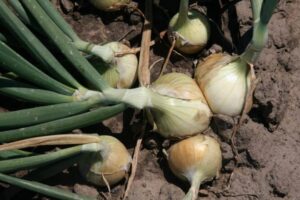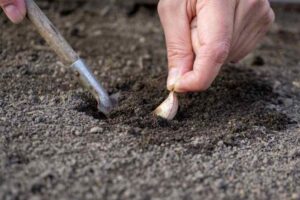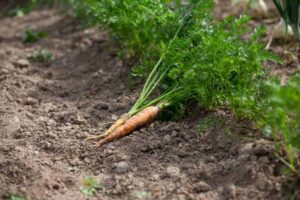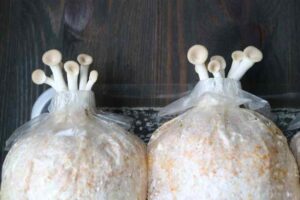
In Oklahoma, potatoes thrive thanks to the state’s unique climatic conditions. If you’re interested in growing your own potatoes in this great state, timing is crucial.
According to research, the best time to plant potatoes in the region is in early spring, around late February to early March. As cool-season crops, potatoes require the chill in the air to germinate properly, yet they also need sufficient time to mature before the heat of summer kicks in. In Oklahoma, the moderate spring climate provides the ideal conditions for potatoes to flourish.
So, now that you’ve got the timeline down, are you ready to delve into the fascinating world of potato planting? Our comprehensive guide will take you through the steps, from picking the right variety to preparing the soil and implementing the best care practices. The bounty of Oklahoma waits for you. Ready to dig in?
Understanding Oklahoma’s Climate for Potato Planting
Oklahoma’s climate is a blend of humid subtropical and semi-arid, leading to warm summers and mild winters. The state experiences plenty of sunshine and rainfall throughout the year, which is beneficial for potato growth.
However, the summers can be quite hot, which can be stressful for potatoes if they’re not harvested in time. Thus, understanding Oklahoma’s climate is key when considering when to plant potatoes. Aim to get your potatoes in the ground early enough that they mature before the peak of summer.
When to Plant Potatoes in Oklahoma
Knowing when to plant potatoes in Oklahoma is crucial to obtaining a good yield. The soil needs to be just the right temperature for planting – not too cold, not too hot. The optimal time for planting potatoes in Oklahoma is in early spring, typically late February to early March. This ensures that the soil has had time to warm up after winter, but isn’t too hot that it could harm the potato seedlings.
In Oklahoma, the average soil temperature in late February to early March ranges between 45-50°F (7-10°C), which is the sweet spot for planting potatoes. Any colder, and the seeds could rot in the ground. Any hotter, and the heat could stress out the young potato plants. So if you’re wondering when to plant potatoes in Oklahoma, keep your eye on the thermometer and aim for that early spring timeframe.
Why Early Spring is the Ideal Time to Plant Potatoes in Oklahoma
The early spring weather in Oklahoma provides a couple of key advantages for growing potatoes. Firstly, the soil temperature is perfect for potato growth. Potatoes prefer cooler soil, and planting in early spring ensures the soil is neither too hot nor too cold.
Secondly, early spring planting allows the potatoes plenty of time to mature before the intense summer heat kicks in. Potatoes take anywhere from 70-120 days to mature, depending on the variety. By planting in early spring, your potatoes should be ready to harvest by early to mid-summer, before the hottest part of the year.
Choosing the Right Potato Variety for Oklahoma
Oklahoma’s diverse climate is well-suited to a range of potato varieties. Some of the best options include Russet, Red Pontiac, and Yukon Gold. These varieties tend to thrive in Oklahoma’s unique climate and soil conditions.
Each variety has a different maturity time, so consider this when choosing which type to plant. For example, Russet potatoes take longer to mature than Red Pontiacs, so plan your planting time accordingly.
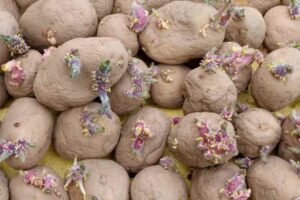
Preparing Your Soil for Potato Planting in Oklahoma
Proper soil preparation is a crucial step before planting potatoes. Oklahoma’s soil tends to be rich in clay, which is beneficial for holding moisture but can be challenging for root growth. To create the best environment for your potatoes, consider amending your soil with compost or well-rotted manure to improve its texture and nutrient content.
The ideal pH for potato growth is between 5.0 and 6.0, so test your soil’s pH and adjust it if necessary using lime (to raise the pH) or sulfur (to lower it).
How to Plant Potatoes
Potatoes are planted from seed potatoes, which are pieces of tubers that contain ‘eyes’ from which new plants grow. Plant the seed potatoes about 3 inches deep and 12 inches apart in rows that are 3 feet apart. The cut side, where the eye is, should be facing up. Lets see the step by step process.
Step 1: Choose Your Potato Variety
There are a large number of potato varieties available. Some varieties are better suited to certain types of dishes, so choose according to your preference.
Step 2: Prepare the Seed Potatoes
Seed potatoes are small potatoes or pieces of potatoes that have at least one “eye” or growth point on them. You can buy these from a garden store, or prepare your own by cutting larger potatoes into chunks, each with at least one eye. If you cut your own, let them dry out for a couple of days to form a protective layer over the cut surface.
Step 3: Prepare the Soil
Potatoes grow best in well-drained, loose soil. If your soil is heavy clay or very sandy, you may want to amend it with compost or other organic matter. The soil should have a slightly acidic pH.
Step 4: Plant the Seed Potatoes
Dig a trench about 6 inches deep. Plant the seed potatoes with the eyes facing up, spacing them about 12 inches apart in the trench. Rows should be spaced about 3 feet apart.
Step 5: Cover the Seed Potatoes
Cover the seed potatoes with about 3 inches of soil. As the plants start to grow, continue to add more soil or mulch to the mound, leaving a few inches of the plant exposed. This process is called “hilling” and it protects the potatoes from the sun and helps increase the yield.
Step 6: Water and Care for Your Plants
Potatoes need consistent moisture, so water regularly, especially during dry periods. However, avoid overwatering, as this can lead to rot.
Step 7: Harvest the Potatoes
Potatoes are typically ready to harvest when the foliage has died back, which is about 10-20 weeks after planting, depending on the variety. You can also do a preliminary harvest of “new” potatoes a few weeks after the plants have finished flowering. Use a spade or fork to carefully dig around the plants to avoid damaging the tubers.
Note: Potatoes like cool weather and should be planted in early spring or late summer, depending on your region. Also, rotating your potato crop to a new location each year can help prevent disease.
Common Challenges and Solutions for Growing Potatoes in Oklahoma
Growing potatoes in Oklahoma can come with certain challenges, including dealing with the state’s clay-heavy soil and the risk of certain pests and diseases. However, with the right strategies, you can overcome these challenges and grow a successful potato crop.
Caring for Your Potato Plants in Oklahoma
Potato plants require regular care to thrive. This includes watering, hilling, and monitoring for pests and diseases. With proper care, your potato plants should grow robustly and produce a bountiful harvest.
Additional Tips for Growing Potatoes in Oklahoma
- Choose potato varieties that are resistant to common potato diseases.
- Rotate your crops annually to prevent soil-borne diseases.
- Protect young plants from late frosts by covering them with a layer of straw or a frost cloth.
- Always water your plants early in the day to allow the foliage to dry before nightfall, reducing the risk of fungal diseases.
Frequently Asked Questions
What kind of potatoes grow best in Oklahoma?
Answer: In Oklahoma, Yukon Gold, Red Pontiac, and Kennebec potatoes generally grow well due to their resilience and adaptability to various soil conditions. However, the specific type that will grow best can also depend on the exact soil and weather conditions of your specific location.
How long do potatoes take to grow in Oklahoma?
Answer: Potatoes take anywhere from 70-120 days to mature, depending on the variety.
What type of potatoes should I plant in Oklahoma?
Answer: Russet, Red Pontiac, and Yukon Gold potatoes tend to thrive in Oklahoma’s climate and soil conditions.
How do I prepare the soil for planting potatoes in Oklahoma?
Answer: Improve your soil’s texture and nutrient content by adding compost or well-rotted manure. Ensure the pH is between 5.0 and 6.0 for optimal potato growth.
When should I harvest my potatoes in Oklahoma?
Answer: Potatoes are generally ready to harvest when the foliage begins to yellow and die back.
Conclusion
Growing potatoes in Oklahoma can be a rewarding experience if done right. By understanding when to plant potatoes in Oklahoma and how to care for them throughout the growing season, you’ll be well on your way to a bountiful potato harvest.

